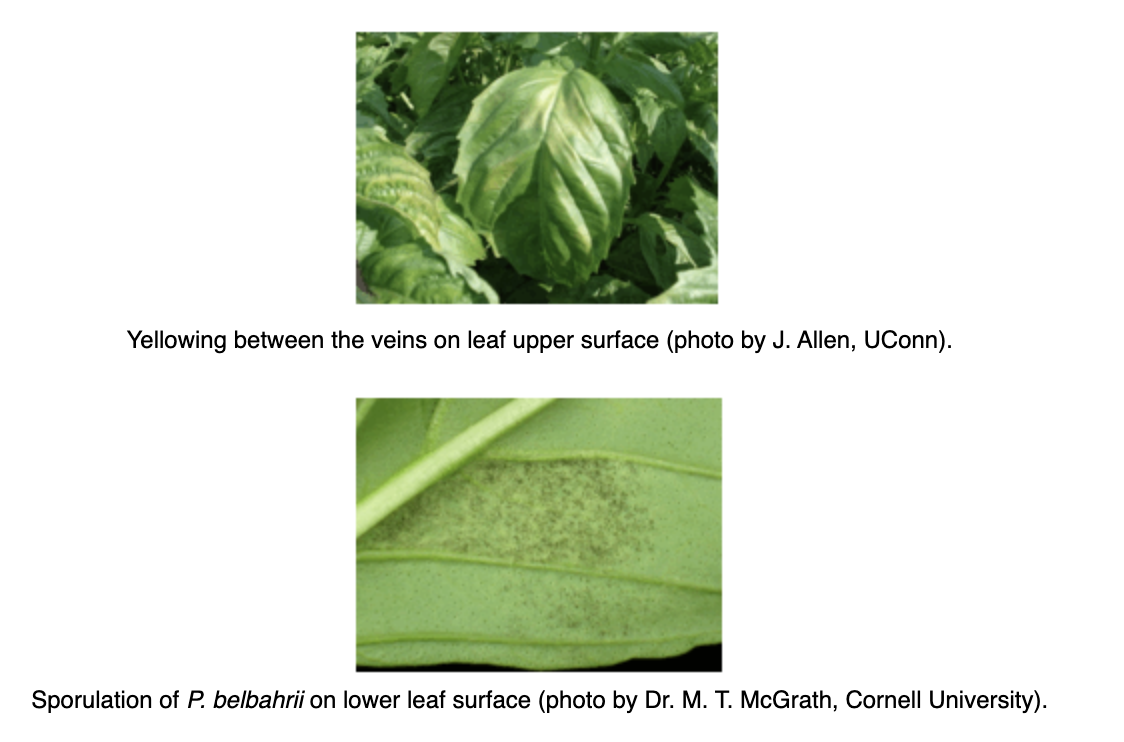Basil downy mildew is caused by the fungus-like pathogen Peronospora belbahrii. This disease was first confirmed in the United States in Florida in 2007. By 2008, it was widespread in the northeast and has been present each season since. The pathogen does not overwinter in the north. It is seed-borne and spreads by wind-borne spores (sporangia) that move north during the summer. Infection renders the basil unsuitable for fresh market sale.
Hosts of the basil downy mildew pathogen include both culinary and ornamental basil varieties. In resistance evaluation trials done in New Jersey (Wyenandt et al., 2009), sweet basil varieties (Ocimum basilicum) were generally more susceptible than O. citriodorum and O. americanum.
Symptoms begin as yellowing that is restricted by the veins on the upper surface of the leaf followed by death of the leaf tissue. Early symptoms can resemble nutrient deficiency. During wet or humid weather, sporulation will be visible on the undersides of the leaves associated with the yellow areas. The sporulation is purplish brown to grayish and has a fuzzy or dirty appearance. These sporangia are wind-blown and rain splashed to new infection sites. See images of symptoms and sporulation in the photos below.

Management Practices
Cultural
- Promote good air circulation by using generous plant spacing and orienting the rows parallel to the prevailing wind direction.
- Avoid overhead irrigation or water early in the morning to promote leaf dryness.
- Plant in full sun.
- In greenhouses, reduce humidity by using fans, lights or raising the temperature.
- Use clean seed. A seed testing procedure is being developed. Do not use seed from infected plants.
- Grow less susceptible varieties. Sweet basil varieties that had less severe downy mildew in trials include ‘Red Leaf’ and ‘Red Rubin’.
Biological and Chemical control
A number of biocontrol and biorational products are labeled for basil and/or downy mildew. In field studies, results are variable from one season or location to another. In some cases, a particular product will be effective and in other studies, it will not perform significantly better than the untreated control.
In studies done at UConn in 2011 (Allen, 2012), OxiDate and Milstop performed well. In other studies, OxiDate did not provide control (McGrath and Hunsberger, 2010, 2011). Other products that have been effective in some tests include Serenade MAX, Actinovate and Trilogy. McGrath and Hunsberger also field tested Sonata, Regalia, and other products but did not get effective control in 2011 when weather was very favorable for the pathogen. All biocontrol and biorational products must be applied preventively to be effective. During the past few years, basil downy mildew has been confirmed in Connecticut in the field by the end of July and in the greenhouse as early as May.
For additional chemical control options see current recommendations.
A monitoring program for basil downy mildew in the northeast has been set up each year since 2009 by Cornell University. Anyone who has diagnosed basil downy mildew in the greenhouse, field, or home garden can report their findings. This information will help predict when the disease might be expected in a particular area and contribute to the understanding of how the pathogen survives and spreads. To access the reporting spreadsheet, go to the fact sheet at the link below and click on the link for reporting your observations. A spreadsheet has been set up for 2012.
References
- Allen, J. E. 2012. Evaluation of organic control products for basil downy mildew, 2011. Plant Disease Management Reports 2012 (in press).
- McGrath, M. T. and L. K. Hunsberger. 2011. Evaluation of biopesticides for managing downy mildew in basil, 2010. Plant Disease Management Reports 2011.
- McGrath, M. T. and L. K. Hunsberger. 2012. Evaluation of biopesticides for managing downy mildew in basil, 2011. Plant Disease Management Reports 2012 (in press).
- Wyenandt, C. A., J. E. Simon, M. T. McGrath and D. L. Ward. 2010. Susceptibility of basil cultivars and breeding lines to downy mildew (Peronospora belbahrii). HortScience 45(9):1416-1419.
By: Joan Allen, Assistant Extension Educator, University of Connecticut. 2012
This information was developed for conditions in the Northeast. Use in other geographical areas may be inappropriate.
The information in this document is for educational purposes only. The recommendations contained are based on the best available knowledge at the time of publication. Any reference to commercial products, trade or brand names is for information only, and no endorsement or approval is intended. The Cooperative Extension System does not guarantee or warrant the standard of any product referenced or imply approval of the product to the exclusion of others which also may be available. The University of Connecticut, Cooperative Extension System, College of Agriculture and Natural Resources is an equal opportunity program provider and employer.